Create Vouchers for Sales and Sales Returns Under VAT in GCC
Selling goods or services is an important part of doing business and it is equally important to record such sales. As part of the business, you may also need to record any sales returns from your customer. In TallyPrime, you can record sales and sales returns through sales vouchers and credit notes, respectively. As a registered VAT dealer, you can sell goods or services to any other registered or unregistered dealers situated locally or in other GCC countries.
When you sell goods or services locally to registered or unregistered dealers, you charge tax to the customers and pay the same to the government. At the same time, you can sell the goods or services to other GCC countries where you will not charge any tax as the customer pays the tax under the reverse charge mechanism. The reverse charge mechanism is defined in the GCC Unified VAT Agreement as the mechanism by which the taxable customer is obligated to pay the tax due on behalf of the supplier. You can record the sale of goods and services together in a single invoice, overseas tourist sales, supply on profit margin, transfer of rights to use, and subsequent sales after import and export sales.
Record sales in single invoice: While recording the sales invoice, you can combine accounting for both the sale of goods and services or a taxable and exempt sale together with additional expenses in a single invoice. For example, while selling a television, you also provide installation services. Instead of raising two separate invoices, you can combine the sale of goods and services in a single invoice. You can also add any additional expenses to the same invoice, such as delivery charges.
Export sales: When you sell to other countries outside GCC, the tax on such sales is paid by the customer based on a reverse charge mechanism.
Overseas tourist sale: In the case of an overseas tourist sale, the customer can claim the tax paid by him by showing the tax receipt.
Supply on Profit Margin; In the business of selling antiques or collector’s items, you can charge VAT on the profit margin and not on the entire amount.
Transfer of rights to use: In the case of transferring ownership rights of goods, the consideration you have paid will be taxable.
Print Sales Invoices in Bilingual: Once the sales vouchers are recorded, you can print the invoices in bilingual (English & Arabic) as per the FTA requirement.
In the case of subsequent sales after import to other GCC countries, or sometimes outside GCC countries, you will not be charged VAT. To increase the sale of your business you may decide to give discounts at the time of sale. You can record such discounted sales and print in the invoices the amount before the discount and the amount of the discount.
Once you have sold the goods or services, your customer may return the goods or services for various reasons. You need to record the sales return, including the tax.
In TallyPrime, you can override the tax details, and, in the process, you can change the nature of the transaction, taxable value, and tax rate.
Record Local Supply of Goods and Services
When you sell your goods or services locally to registered or unregistered dealers, such sales are referred to as domestic sales. In TallyPrime, you can record sales of goods or stock items using the Item Invoice mode and specify the stock item details, quantity, and rate. Similarly, the sale of services can be recorded using the accounting invoice mode. An accounting ledger is not required as there is no stock item to allocate.
- Open the Sales Voucher in Item Invoice mode.
- Press Alt+G (Go To) > Create Voucher > press F8 (Sales).
Gateway of Tally > Vouchers > F8 (Sales). - Press Ctrl+H (Change Mode) to select Item Invoice mode.
- Press Alt+G (Go To) > Create Voucher > press F8 (Sales).
- Record the Sales Voucher.
- Print the Sales Voucher.
- Press Page Up key to view the invoice in alteration mode.
- Press Alt+P (Print) > press Enter on Current
- In the Voucher Printing screen, press C (Configure).
- Type or select Print Type > and press Enter to select Single or Bilingual.
- If the Print Type is Single > press Enter on Print Language to select English or Arabic.
- Type or select Invoice Format > press Enter to select Invoice Format 2.
- Press I (Preview) to preview before printing or press P (Print) to print.
To learn more about printing invoices as per FTA, click here. After recording the voucher, you can view the transaction under Local Supplies in VAT 201.
Sales Within GCC Countries
Sales made within VAT-implementing GCC countries to registered dealers are not taxable. The buyer will pay the tax on a reverse charge basis. However, if the buyer is an unregistered dealer, you can charge VAT during sales. For example, suppose you are a registered dealer located in UAE and supply goods or services to a registered dealer in Saudi Arabia or Bahrain. In that case, no tax will be applied in the sales transaction, but the buyer will have to pay tax on a reverse charge basis. However, if you are supplying to an unregistered dealer in Saudi Arabia or Bahrain, tax is applicable.
You can sell goods or services to registered or unregistered dealers in other GCC countries. Selecting a party from another GCC country automatically sets the Nature of transaction to intra-GCC Supplies.
- Ensure the Nature of transaction for the sales ledger is Not Applicable.
- Record the Sales Voucher.
- Accept the screen. As always, you can press Ctrl+A to save the sales voucher.
- View the VAT – Tax Analysis screen.
After recording the voucher, you can view the transaction under GCC Supplies in VAT 201.
Record Sales in a Single Invoice
If you are in the business of selling both goods and services, then you can record both in a single invoice. For example, if you are selling a refrigerator or television and along with that you are also providing installation service then you can record both the sale of goods and services in a single invoice. Additionally, if you are selling goods or services which are taxable and also exempt from tax then you can record both taxable and exempt supplies in a single invoice. For example, if you are selling financial services, then that is exempted from tax hence while creating the ledger select the Nature of transaction as Domestic Exempt Supplies.
- Open and record the Sales voucher.
- Press Alt+G (Go To) > Create Voucher > press F8 (Sales).
Gateway of Tally > Vouchers > F8 (Sales). - Select the Party A/c name and Sales ledger.
- Select the required stock item including quantity and rate.
- Select the required service ledger.
- Select the VAT ledger.

- Accept the screen. As always, you can press Ctrl+A to save the sales voucher.
- Press Alt+G (Go To) > Create Voucher > press F8 (Sales).
- View the VAT – Tax Analysis screen.
Once you combine accounting both the sale of goods and services or a taxable and exempted sale together, you can share a single invoice to your customer. You can view the transaction under Local Supplies in VAT 201.
Record Sales with Additional Expense
While recording the sale of goods or services, you may incur additional expenses such as delivery charges, installation charges, packing charges and so on. You can appropriate such expenses to the value of goods or services for calculating VAT. For example, you are selling television and also providing the installation services. Here the installation charges are an additional expense which you can appropriate to the value of the television and then calculate VAT.
- Configure the additional expense ledger.
- In the additional expense ledger, for example, Installation Charges, configure the below options.
- Taxability is set to Not Vatable
- Include in assessable value calculation for is set to VAT
- Appropriate to is set to Goods.
- Method of calculation is set to Based on Quantity or Based on Value.
- As always, press Ctrl+A to save the purchase ledger.
- In the additional expense ledger, for example, Installation Charges, configure the below options.
- Open and record the Sales voucher in Item Invoice mode.
- Press Alt+G (Go To) > Create Voucher > press F8 (Sales).
Alternatively, Gateway of Tally > Vouchers > press F8 (Sales). - Press Ctrl+H (Change Mode) and select Item Invoice mode.
- Select the Party A/c name and Sales ledger.
- Select the required stock item including quantity and rate.
- Select the additional expense ledger configured and enter the amount.
- Select the VAT ledger.

- Press Alt+G (Go To) > Create Voucher > press F8 (Sales).
- View the VAT – Tax Analysis screen.
- Accept the screen. As always, you can press Ctrl+A to save the sales voucher.
Similarly, you can record sale of services by selecting the Method of Calculation as Based on Value. After recording the voucher, you can view the transaction under Local Supplies in VAT 201.
Sales with Discount
While selling the goods or services you can give dicounts to your customer and record the same in the sales voucher. Such discount can be a fixed percentage, an amount off or even buy-one-get-one-free offer. The tax is calculated on the discounted price. In TallyPrime, you need to create the Discount ledger under expense group and select the Type of Ledger as Discount.
- Configure discount ledger.
- In the Ledger Creation screen, create the Discount ledger under Indirect Expenses.
- Select the Type of Ledger as Discount.
- Press Ctrl+A to accept the Ledger Creation screen.
- Record the Sales voucher with Discount.
- Print the invoice.
- Press Alt+P (Print) > press Enter on Current.
- Press C (Configure).
- Type or select Print Type > and press Enter to select Single or Bilingual.
- If the Print Type is Single > press Enter on Print Language to select English or Arabic.
- Type or select Invoice Format > press Enter to select Invoice Format 2.
- Type or select Show Before Discount & Invoice Discount > press Enter to enable it.
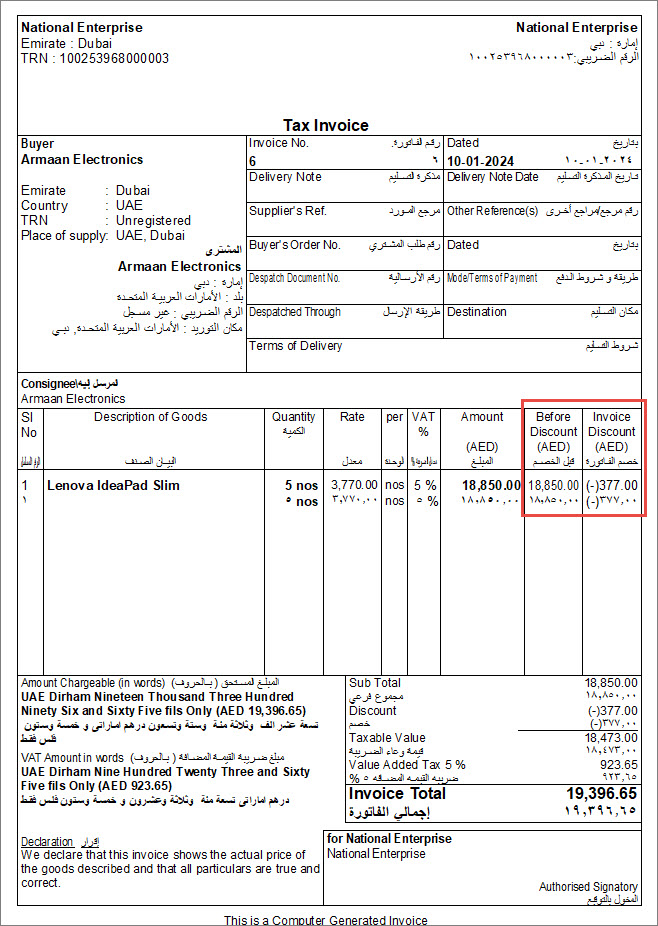
After recording the voucher, you can view the transaction under Local Supplies in VAT 201.
Sales to Overseas Tourists
Sales made to overseas tourists are taxable at the point of sale. However, the tourist can claim the tax amount by showing the tax receipt before leaving the country. You can record the sale to Overseas Tourist like regular sale entry and mark the transaction as sale to overseas tourist to differentiate it from regular sales. This can be done for POS invoices as well.
- In the sales invoice, set the option Provide VAT details to Yes.
- In the VAT Details screen, set the option Is Overseas Tourist to Yes.

- Press Ctrl+A to accept.
You can mark a Point of Sale (POS) invoice as an overseas tourist sale.
- In the POS invoice, select Not applicable in the Party A/c name field.
- In the Party Details screen, set the option Is Overseas Tourist to Yes.
If you do not see this option, press F12 (Configure) > set Skip Overseas Tourist field to Yes.
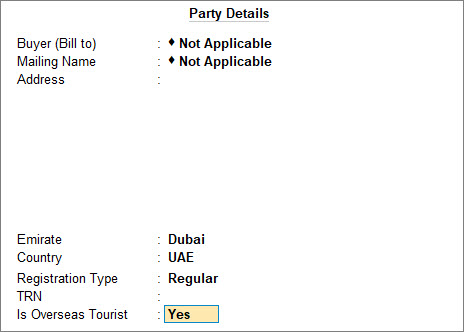
- Enter all the other details in the invoice.
- Accept the screen. As always, you can press Ctrl+A to save.
After recording the voucher, you can view the transaction under Local Supplies in VAT 201.
Export Sales
When you sell to parties outside GCC or to countries within GCC where VAT is not implemented such as Kuwait and Qatar, such sale is called Export Sales. In both cases, once you select the party, TallyPrime automatically categories them as exports and does not calculate tax. The customer pays the tax on a reverse charge basis. You can record the export of goods using a sales voucher. Selecting a party from outside GCC country automatically sets the Nature of transaction to Export sale.
- Ensure the Nature of transaction for the sales ledger is Not Applicable.
- Record the Sales Voucher.
- Accept the screen. As always, you can press Ctrl+A to save.
After recording the voucher, you can view the transaction under Outside GCC Supplies in VAT 201.
Supply on Profit Margin
The profit margin scheme of tax applies to second-hand goods, antiques, and collector’s items, where tax is applied on the profit margin achieved on the supply rather than the full value. Therefore, the tax liability is applicable only on the profit margin. In TallyPrime, since tax is not charged on the entire amount, the tax liability for the profit margin is recorded using an adjustment journal voucher.
To ensure that there is no tax applicability on the purchase and the sale of the same stock item, but only on the profit margin on sale the purchase of used goods for sale on profit margin should be recorded by selecting Domestic Purchase – Profit Margin as the Nature of transaction.
- Configure the Nature of transaction for the sales ledger.
- In the sales ledger, select Domestic Supplies – Profit Margin as the Nature of transaction.
- As always, press Ctrl+A to save the sales ledger.
- Record the Sales ledger.
- Select the customer in Party A/c name.
- Select the sales ledger.
- Select the used stock item purchased for sale on profit margin.
- Enter the Quantity and Rate. Press Enter in the Amount field to display Profit Margin Details screen.
- Enter the details with respect to the vendor from whom the goods were purchased, as shown below:
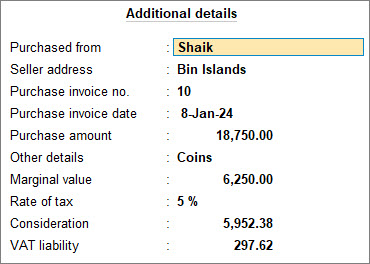
- Other details: Here you can provide a brief description of the goods.
- Marginal value: This displays the sales value after deducting the purchase amount.
- Consideration: This value refers to the profit or revenue generated in this sales transaction.
- VAT liability: This value refers to the tax amount calculated on the Consideration.
- Press Enter to return to voucher.

- Accept the screen. As always, you can press Ctrl+A to save.
You can now record a journal voucher to book the tax liability on profit margin. You need to select the Nature of Adjustment as Increase in Tax Liability and Additional Details as Sale on Profit Margin. To know more about recording tax liability, click here.
After recording the voucher, you can view the transaction under VAT on Marginal Scheme in VAT 201.
Transfer of Right to Use
When the ownership of goods is transferred to another business for a certain period, the amount paid for the right to use the goods is taxable. The transactions are recorded only for the consideration amount, and the actual value of the goods is not included in the transaction.
- Configure the Nature of transaction for the sales ledger.
- In the sales ledger, select Domestic Supplies – Transfer of Right to Use as the Nature of transaction.
- As always, press Ctrl+A to save the sales ledger.
- Record the Sales ledger.
- Accept the screen. As always, you can press Ctrl+A to save.
After recording the voucher, you can view the transaction under Local Supplies in VAT 201.
Subsequent Sales
When you import goods for subsequent sale, you will be paying tax on the import of goods. The subsequent sale to other GCC countries, or sometimes outside GCC countries, will not be taxable. While recording subsequent sales to Intra GCC customers, select the sales ledger with the Nature of transaction selected as Not Applicable for the system to decide the Nature of transaction depending on the location of your party.
To recover your expenses incurred by paying VAT on imports, you can add the tax value to the value of the goods or include it as an additional expense in the sales transaction.
- Ensure the Nature of transaction for the sales ledger as Not Applicable.
- Record the Sales Voucher.
- Accept the screen. As always, you can press Ctrl+A to save.
Similarly, you can record the subsequent sales to customers outside GCC countries. You need to select a customer outside the GCC country for the system to decide the Nature of transaction as Exports. After recording the voucher, you can view the transaction under GCC Supplies in VAT 201.
Record Sales with Excise and VAT
When you apply excise to an item, the excise amount should be included in the item value to calculate VAT. For example, if the item cost is 500 AED and excise is 50 AED, then the VAT is calculated on 550 AED. In TallyPrime, you can account for excise and calculate VAT by including the excise amount.
You have to enable excise for stock items and ledgers to be able to calculate excise in transactions. To account for excise, a separate ledger has to be created by selecting Excise as the Type of ledger.
- Enable excise for stock items.
- Press Alt+G (Go To) > Create Master > Stock Item > and press Enter.
Alternatively, Gateway of Tally > Create > type or select Stock Item > and press Enter. - Create the stock item.
- Set the option Is Excise Applicable to Yes.
If you do not see this option, press F12 (Configure) and set Use Excise to Yes.
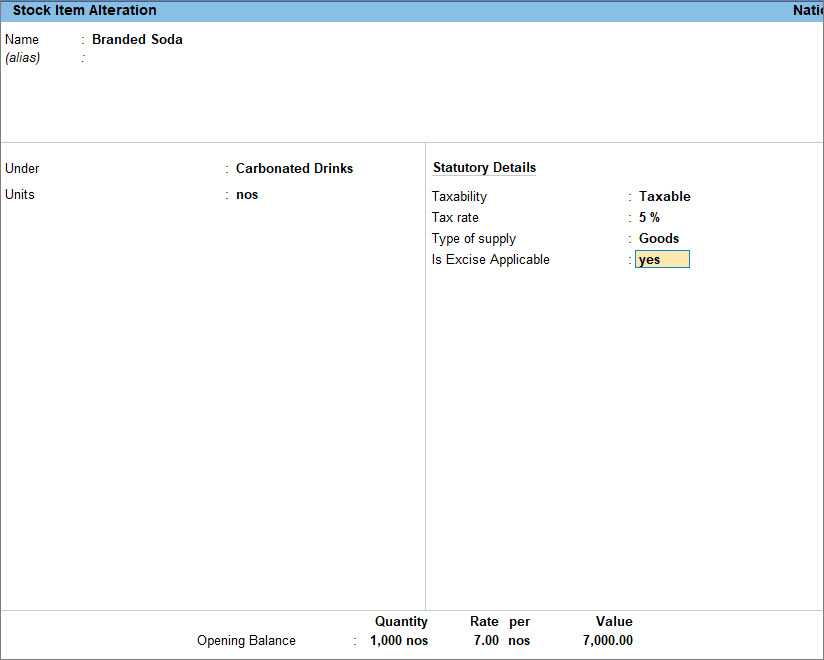
- Accept the screen. As always, you can press Ctrl+A to save.
- Press Alt+G (Go To) > Create Master > Stock Item > and press Enter.
- Configure the excise ledger.
- Record transactions to calculate excise and VAT.
- In the Sales voucher, press F12 (Configure).
- Set Calculate Excise Duty to Yes and press Ctrl+A to save.
- Select the Party A/c name and Sales ledger.
- Select the excise applicable item under Name of Item and enter the quantity and rate.
- In the Excise Value field, enter the excise rate or excise amount.
When you enter the rate, the excise amount appears next to the rate. - Select the excise duty ledger created.
The excise amount appears automatically. - Select VAT ledger. VAT is calculated based on the value of the item plus excise.

- Accept the screen. As always, you can press Ctrl+A to save.
After recording the voucher, you can view the transaction under Local Supplies in VAT 201.
Change Tax Details in Invoice
While recording sales, you may require changing the taxable value or the Nature of transaction depending on the transaction recorded. The Nature of transaction is selected as Not Applicable, for the sales ledger so that the system can automatically select the Nature of transaction depending on the location of your customer. However, for a particular transaction, you may require selecting a Nature of transaction overriding the selected Nature of transaction. In TallyPrime, you can override the tax details in transactions by enabling modify tax rate in the sales invoice. You can change the nature of transaction, taxable value, and tax rate, as required.
- Open the Sales voucher and enable modify tax rate.
- Press Alt+G (Go To) > Create Voucher > press F8 (Sales).
- Press F12 (Configure) > set Modify Tax Rate details for VAT to Yes.
- Record the Sales voucher.
- Press O to override the default tax details.
After recording the voucher, you can view the transaction under Local Supplies in VAT 201.
Print Sales Invoices
After recording the sales voucher, you need to print the sales invoices to share it with the customer. You can print the invoices immediately after recording the voucher or you can choose to print them later. If your company is located in UAE, then you need to print the sales invoices as per the FTA guidelines. You can print the invoices in English, Arabic or in both languages and also select the invoice format.
You can configure your print settings as per your requirement by including the fields you want to view in the invoice. For example, if you have recorded a sale with rate inclusive of VAT, you can configure the print setting to show a separate column as Rate (Incl VAT). TallyPrime also optimises the print area for the selected paper size to print maximum information on a single page.
The margins on top and left for the header and the columns in the printed invoice are pre-configured. If you reduce these header margin measurements, the alignment of the fields in the printed invoice will be affected. It is suggested that you should avoid altering the default margins in the invoice. In unavoidable circumstances, you can make small changes to the measurement. However, if additional columns and fields are added using F12 (Configure), the alignment will be affected due to the altered margins.
In this section
Print sales invoice in bilingual
Depending on your requirements, you can include the relevant details in your invoice.
- In the Voucher Printing screen of the sales invoice, press C (Configure).
- Type or select Show Rate (Incl. VAT) > and press Enter to enable it. This will print the rate of each item inclusive of tax.
- Type or select Print Type > and press Enter to select Single or Bilingual.
- If the Print Type is Single > press Enter on Print Language to select English or Arabic.
- Type or select Invoice Format > press Enter to select Invoice Format 2 to print as per FTA.
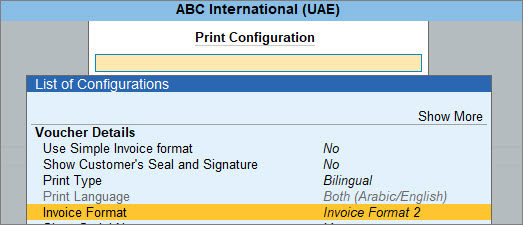
- You can also print the invoice in simple invoice format by setting the option Use Simple Invoice format to Yes in the Print Configuration screen.

The printed invoice appears, as shown:

Once the invoice is printed in bilingual format, you can view the invoice both in English and Arabic.
Print sales invoice with rate inclusive of VAT
After the sale of goods or services, if you need to print the invoice with a rate inclusive of tax, you can do that in TallyPrime. You have the flexibility to manually enter the rate inclusive of VAT in the invoice and print or configure TallyPrime to auto-calculate the same. To enter manually you need to set Provide Rate Inclusive of Tax for Stock Items to Yes in the F12 (Configure) and to auto calculate the rate inclusive of VAT, disable Provide Rate Inclusive of Tax for Stock Items.
- Create Sales Voucher with rate inclusive of VAT.
- Print the invoice with rate inclusive of VAT.
- Press Ctrl+P (Print) to print the invoice.
- In the Voucher Printing screen of the invoice, press C (Configure) > type or select Show Rate (Incl. VAT) > and press Enter to enable it. Press Esc to save the configuration screen.
- Print the invoice. The invoice printed in Bilingual using Invoice Format 1, appears as shown:
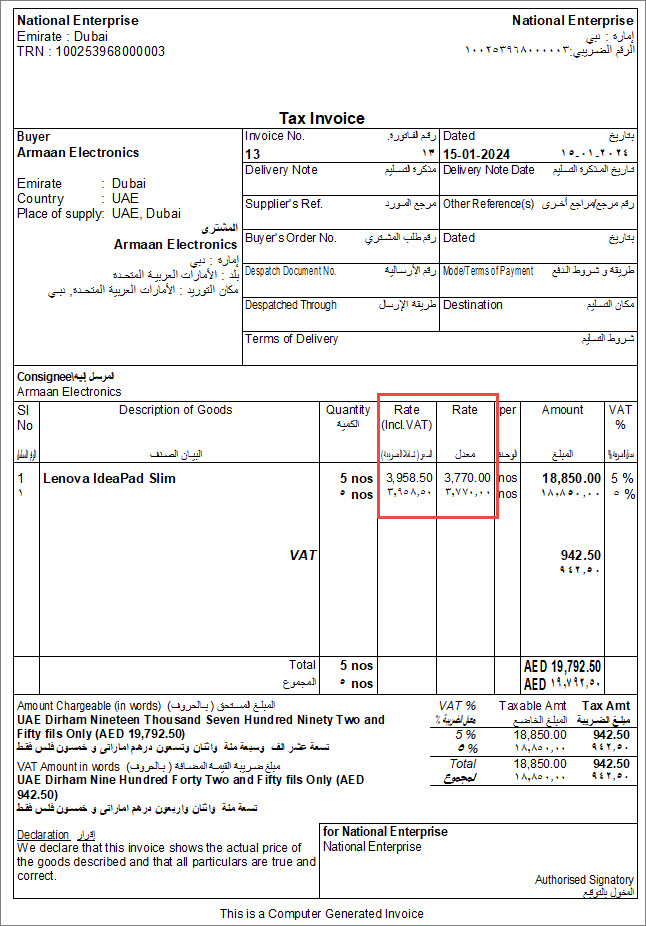
With the configuration, you can view a separate column displaying the rate of the stock item including VAT.
Sales Returns
After you have sold goods or services to your customers, they may return such goods or services for a variety of reasons. Your customer may return the goods due to low-quality products, damaged product, late delivery, surplus delivery, and more. In TallyPrime, you can record the sales returns in partial or full against the sales invoice using Credit Notes.
- Press Alt+G (Go To) > Create Voucher > press F10 (Other Vouchers) > type or select Credit Note > and press Enter.
Alternatively, Gateway of Tally > Vouchers > press F10 (Other Vouchers) > type or select Credit Note > and press Enter. - In Party A/c name, select the party to whom the original sales were made.
Receipt Details and Original Invoice Details screen appears. - In the Original Invoice Details screen, enter the invoice number of the original sales transaction against which you are recording the current sales return and the Date.
- Select the items to be returned, enter the quantity being returned, and press Enter.
The Provide Original Invoice Details screen appears. - Enter the taxable amount and tax amount from the sales transaction against which the returns are recorded in the Original Taxable Amount and Original Tax Amount fields respectively.

- Select the VAT ledger.
- Set the option Provide VAT details to Yes and select the Reason for Returns.

- Accept the screen. As always, you can press Ctrl+A to save.
When a credit note is recorded for the return of goods, only nett value is displayed in the returns and not the gross value.














